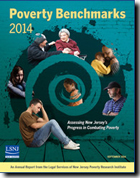 |
 |
 |
|
|

|
| |
Poverty Benchmarks 2014 |
|
|
|
- The relative cost of living in New Jersey is so high that real poverty amounts to 250 percent of the official poverty level.
- Based on 250 percent of the FPL, there are 2.7 million impoverished New Jerseyans, including 780,000 children.
- Forty-nine percent of black residents and 54.6 percent of Hispanic or Latino residents were below 250 percent of the FPL in 2012.
- Of residents between the ages of 18-24, nearly 40 percent were below 250 percent of the FPL. The poverty rate for those 75 years and over was even higher, at 41.6 percent; children below six years had the highest poverty rate at 43.3 percent.
- The counties with the highest population below 250 percent of the FPL—40 percent or more—were Essex, Hudson, Passaic, Atlantic and Cape May together, and Cumberland and Salem together. Four counties—Camden, Mercer, Ocean, and Union—had poverty rates between 30 and 40 percent.
|
|
| |
  The annual Poverty Benchmarks report is an ongoing project of LSNJ’s Poverty Research Institute. Poverty Benchmarks 2014 is the eighth in the series.
As was the case last year, the 2014 report comes out just a few days before the Census Bureau publishes its annual compilations of the Current Population Survey (CPS) and American Community Survey (ACS) 2013 poverty data. Benchmarks 2014 is both a summary and retrospective on the key poverty data made available over the preceding 12 months, and a platform and context from which to assess the forthcoming Census data release.
The report, as in past reports, draws from a variety of data sources. For consistency, and to allow comparison, we emphasize data extracted from the U.S. Census Bureau’s American Community Survey (ACS). These data depict the state of poverty in New Jersey in 2012. We also draw on the PUMS (Public Use Microdata Sample) data produced by the Census Bureau to present various poverty data at 250 percent of the FPL. In addition, this report highlights poverty data at 50 percent, 100 percent, and 200 percent of the official poverty measure to allow for comparisons with reports of previous years.
 Download Poverty Benchmarks 2014 Download Poverty Benchmarks 2014
 Appendix to Benchmarks 2014: Poverty Tables Appendix to Benchmarks 2014: Poverty Tables |
|
|
|
|
|